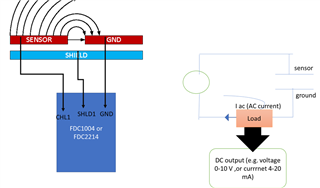Other Parts Discussed in Thread: FDC2214
Hello,
If i use a two-electrode sensor and connect to FDC1004 or FDC2214, I am able to get the capacitance readings. I have represented it by the diagram below

I have the following questions:
1.How to detect AC current if the circuit representation for the schematic is as above (right)? What range are we talking about for 1-15 pF? pA or nA?
2.Is it possible to sense the AC current (Iac) in the circuit? Does TI have an amplifier/current sensor that can detect FDC1004 or FDC2214 AC current levels?Any resistor load is required?
3.How to covert the Iac to DC output (voltage or current)? Does TI have any AC current to Analog DC output convertors?
The idea is to build something similar to commercial capacitive proximity sensor where the output is DC 4-20 mA or 0-10 V. Apologies for the naive questions as I am not an expert in this field.
Thanks
HAri

